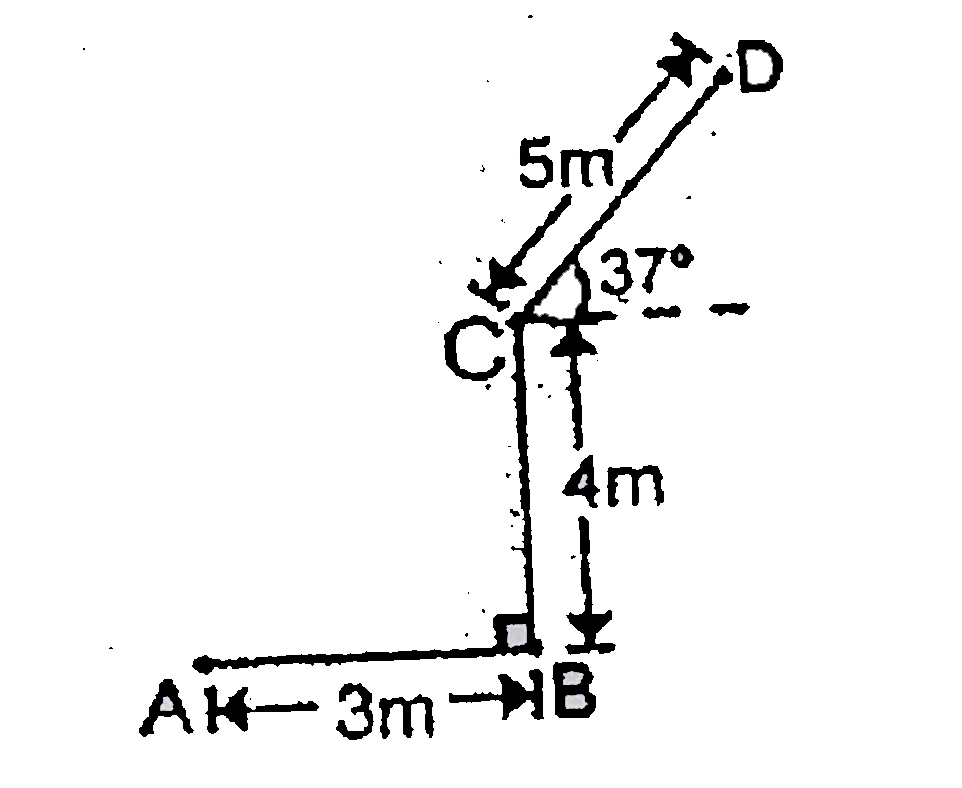An object moves from position (6,8) to (12,10) in the x-y plane. Magnitude and direction of displacement is
√40 and 18.43∘
√40 and 61.56∘
10 and 53∘
√244 and 53∘
The correct Answer is:A
To find the magnitude and direction of the displacement of an object moving from position (6,8) to (12,10) in the x-y plane, we can follow these steps:
Step 1: Define the Initial and Final Position Vectors
- The initial position vector r1 is given by the coordinates (6, 8).
r1=6^i+8^j
- The final position vector r2 is given by the coordinates (12, 10).
r2=12^i+10^j
Step 2: Calculate the Displacement Vector
- The displacement vector r is calculated by subtracting the initial position vector from the final position vector.
r=r2−r1=(12^i+10^j)−(6^i+8^j)
r=(12−6)^i+(10−8)^j=6^i+2^j
Step 3: Calculate the Magnitude of the Displacement
- The magnitude of the displacement vector |r| can be calculated using the Pythagorean theorem:
|r|=√(62+22)=√36+4=√40
Step 4: Calculate the Direction of the Displacement
- To find the direction (angle θ) of the displacement vector with respect to the x-axis, we can use the tangent function:
tan(θ)=oppositeadjacent=26=13
- Therefore, we find θ by taking the arctangent:
θ=tan−1(13)≈18.43∘
Conclusion
- The magnitude of the displacement is √40 and the direction is approximately 18.43∘ from the x-axis.
Final Answer
- Magnitude: √40
- Direction: 18.43∘
---
- The initial position vector r1 is given by the coordinates (6, 8).
r1=6^i+8^j
- The final position vector r2 is given by the coordinates (12, 10).
r2=12^i+10^j
- The displacement vector r is calculated by subtracting the initial position vector from the final position vector.
r=r2−r1=(12^i+10^j)−(6^i+8^j)
r=(12−6)^i+(10−8)^j=6^i+2^j
- The magnitude of the displacement vector |r| can be calculated using the Pythagorean theorem:
|r|=√(62+22)=√36+4=√40
- To find the direction (angle θ) of the displacement vector with respect to the x-axis, we can use the tangent function:
tan(θ)=oppositeadjacent=26=13
- Therefore, we find θ by taking the arctangent:
θ=tan−1(13)≈18.43∘
- The magnitude of the displacement is √40 and the direction is approximately 18.43∘ from the x-axis.
- Magnitude: √40
- Direction: 18.43∘
Topper's Solved these Questions
- MOTIONBOOK - DC PANDEY ENGLISHCHAPTER - MOTIONEXERCISE - Check Point 4.2
20 Videos
- MOTIONBOOK - DC PANDEY ENGLISHCHAPTER - MOTIONEXERCISE - Check Point 4.3
10 Videos
- MOTIONBOOK - DC PANDEY ENGLISHCHAPTER - MOTIONEXERCISE - Medical entrances gallery
19 Videos
- MEASUREMENT AND ERRORSBOOK - DC PANDEY ENGLISHCHAPTER - MEASUREMENT AND ERRORSEXERCISE - Subjective
19 Videos
- MOTION IN A PLANEBOOK - DC PANDEY ENGLISHCHAPTER - MOTION IN A PLANEEXERCISE - (C )Medical entrances gallery
32 Videos
Similar Questions
An object moves from position (3,4) to (6,5) in the xy-plane. Find the magnitude and direction of displacement vector of the particle.
View SolutionA particle moves in xy-plane from position (2m, 4m) to (6m,8m) is 2s. Magnitude and direction of average velocity is
View SolutionA particle moves in xy-plane from position (1m,2m) to (3m,4m) in 2s. Find the magnitude and direction of average velocity.
View SolutionTwo objects AandB are moving along the directions as shown in (Fig. 5.77). Find the magnitude and direction of the relative velocity of Bw.r.t.A.
 ,
,
View SolutionAn electron is moving along +x direction with a velocity of 6×106ms−1 . It enters a region of uniform electric field of 300 V/cm pointing along + y direction. The magnitude and direction of the magnetic field set up in this region such that the electron keeps moving along the x direction will be :
View SolutionA force F=(xˆi+2yˆj)N is applied on an object of mass 10 kg, Force displaces the object from position A(1, 0) m to position B(3, 3) m then the work done by the force is (x and y are meter)
View SolutionAn object is moving in the x-y plane with the position as a function of time given by →r=x(t)ˆi+y(t)ˆj. Point O is at x=0,y=0 . The object is definitely moving towards O when
View SolutionA particle moves along a path ABCD as shown in the figure. Then the magnitude of net displacement of the particle from position A to D is:

View SolutionA point object is placed on the axis in front of a convex lens of focal length 30 cm. The distance of the object from the lens is 45 cm. If the lens is moved away from object by 1 mm and also the object is moved apart from the line joining the object and optical centre by 1 mm the displacement of the image has magnitude-
View SolutionAn object is moving away from concave mirror of focal length f starting from focus. The distance of an object from pole of mirror is x. The correct graph of magnitude of magnification(m) verses distance x is:
View Solution
